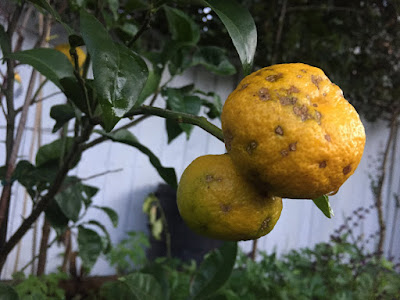There’s been a lot of buzz about Yuzu recently. The exotic flavour of this tiny Japanese citrus fruit supposedly adds a welcome and potent zing to everything from dressing to desserts. Yuzu is a healthy, delicious and unique fruit that provides a surprising burst of complex freshness.
But unless you have a Yuzu tree in the back yard, finding fresh Yuzu fruit can be a difficult task. So about 3 years ago i brought a tree from my local garden centre to see what all the fuss was about. And it is only now that i have finally been able to taste the elusive YUZU! Just tonight i tried my first Yuzu and was thinking how shall i try it? So my first idea was a Yuzu Lemonade so using my lime squeezer i juiced it into a glass with 2 tsp of Caster Sugar and some water. Very little juice can be extracted from the fruit, since it has a thick rind and large seeds relative to its size, but the juice that is available has a concentrated flavor, and juicing it this way releases the fruit’s aromatic oils from the peel also. At first taste i thought "meh, it's not that dissimilar to my Meyer Lemon". But as i kept sipping i found it has an unique floral zestyness unlike any other citrus that was surprisingly moorish. It’s bright & tart and a little bit bitter, as if a grapefruit and a lemon were mixed together.
Yuzu is believed to be a hybrid of sour mandarin and Ichang papeda. The fruit looks somewhat like a grapefruit (though usually much smaller) with an uneven blotchy skin, and can be either yellow or green depending on the degree of ripeness. Yuzu fruits typically range between 5-8 cm in diameter, but can be as large as a grapefruit (up to 10 cm or larger).
Yuzu forms an upright shrub or small tree, which commonly has thorns. Leaves are notable for a large petiole, resembling those of the related kaffir lime, and are scented.
The Yuzu originated and grows wild in central China. It is unusual among citrus plants in being relatively frost-hardy, due to its cold-hardy C. ichangensis ancestry, and can be grown in regions with winters at least as low as -9 °C where more sensitive citrus would not thrive.
Yuzu is highly prized in Japanese Cuisine. The yuzu's flavour is tart, closely resembling that of the Meyer Lemon, Grapefruit, with overtones of Mandarin. It is rarely eaten as a fruit, though in the Japanese cuisine its aromatic zest is used to garnish some dishes, and its juice is commonly used as a seasoning, somewhat as Lemon is used in other cuisines. It is an integral ingredient in the citrus-based sauce Ponzu. It is also used in a variety of foods such as Marmalade, Cakes, Liquors, Yuzu Mayo, Cocktails and Drinks.
Another use of Yuzu is on Winter Solstice, or Toji. A hot bath is drawn and whole or sliced Yuzu fruit is added to the water. Bathing in this water is said to ward off colds and flu during the winter, and to rejuvenate dry, chapped skin as the aromatic oils are released into the water. The nomilin in the fruit’s oils is said to give a relaxing effect and increased circulation. That said i don't think i'll have any to waste on such an extravagance until my tree gets bigger (it's only 1 metre tall).
Main Photo courtesy of Edsel Little

























